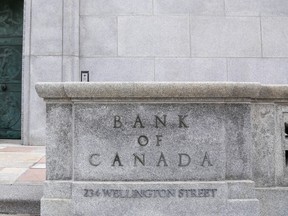Some analysts expect the move to point to a much more aggressive rate hike path for the rest of the year
Article content
The Bank of Canada pushed ahead with its first 50-basis point interest rate hike in 22 years on Wednesday, a move that came as no surprise to economists and bank watchers who had widely anticipated the increase. What comes next, however, is less certain.
Article content
Economist Royce Mendes from Desjardins Group saw the aggressive move — which included announcing that it would begin quantitative tightening, or reducing the amount of government bonds held on its balance sheet, effective April 25 — as an acknowledgement of the need to move “forcefully” to combat rising price and return rates to more neutral levels.
In addition to raising the overnight rate to one per cent, the bank also increased its projection for GDP growth to 4.2 per cent this year, from the initial four per cent laid out in its January monetary policy report and bumped up inflation expectations to a 5.3 per cent average from 4.2 per cent.
Article content
“These revisions come as little surprise given all that’s transpired since the previous estimates were released in January,” Mendes wrote.
“Notably, however, the Bank of Canada is more optimistic on growth in 2023 than us, as we see rate hikes biting earlier and more acutely.”
Desjardins sees room for further tightening into next year, but did not think the Bank of Canada would keep pace with the U.S. Federal Reserve, which is expected to take rates above three per cent.
Paul Ashworth, chief North America economist at London-based research firm Capital Economics, shared the view that Canada’s rate hike path would be lower going forward.
In a note Wednesday morning, Ashworth argued that housing vulnerabilities would keep the Canadian central bank’s hands tied, and that it would likely struggle to get the policy rate much higher than the two per cent mark. The Fed, by comparison, is expected to bring the Fed Funds Rate to a peak of 3.38 per cent.
Article content
“Since housing is more obviously over-valued north of the border, household debt burdens are much higher and rate-sensitive residential investment accounts for a much bigger share of the economy,” Ashworth wrote.
The pressure climbing rates are expected to put on housing and mortgage debt holders will be closely watched in the months ahead.
“Higher and faster rate hikes will affect mortgage affordability for a significant population of homebuyers,” said RatesDotCA expert and licensed mortgage agent Sung Lee in an e-mail to the Financial Post. “Major banks have already pushed fixed rates higher several times over the past few weeks with some approaching the four per cent mark for uninsured products.”
Article content
Analysts at LowestRates.ca expect the move from the Bank of Canada today could point to a much more aggressive rate hike path for the rest of the year.
“Rates are going up this year, but we do not know what next year will bring. This creates a bit of a roller coaster experience for current and would-be homeowners,” Leah Zlatkin, LowestRates.ca’s licensed mortgage broker, said in an e-mail.
“These increased costs have a real impact on homeowners’ wallets,” Zlatkin added. “Some variable-rate holders may think about switching to a fixed rate to bring some stability to their outlook, but anyone with variable rate will still be saving money over a fixed rate right now.”
• Email: shughes@postmedia.com | Twitter: StephHughes95
Economists discuss Bank of Canada’s first 50-point hike in 22 years
2022-04-13 18:28:26





